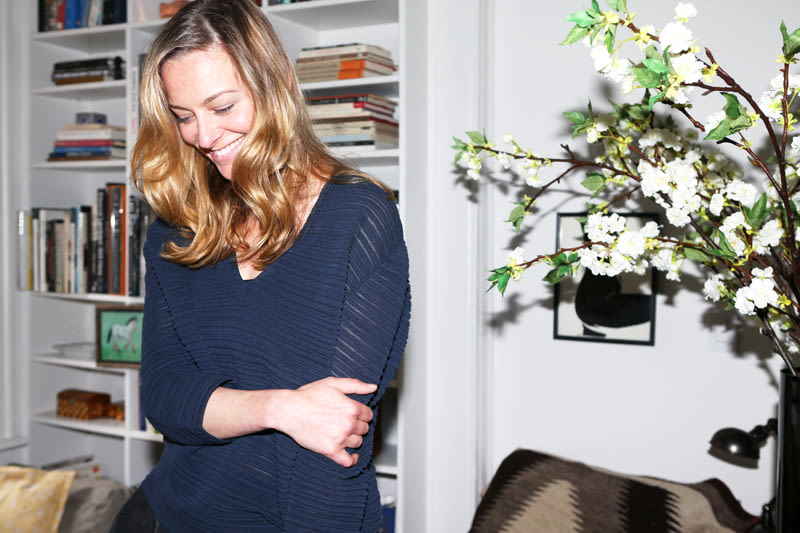'I’m the Fashion and Style Director at Vanity Fair, which involves styling all of the cover shoots, the actors and actresses we feature when the cover isn't someone who's dead. We try to shoot people in a way that’s either interesting, surprising, or outright glamorous; it just really depends on the subject. It’s about figuring out what you or I would be interested in seeing—like, Kristen Stewart, you wouldn’t really be interested in seeing her look grungy, so the idea is to take her completely out of that, and dress her in couture because that’s a more unexpected way to see her. Being at Vanity Fair makes my job easy because you only work with amazing photographers, which makes it less of a struggle overall, but the pressure to actually do something good with these people who always do good things is a whole different bag.
Many of the actresses are so out of their element in front of the camera, which is surprising, and they look at being photographed for a magazine, especially Vanity Fair, as work. They don’t necessarily enjoy the process, so my job becomes a lot like hosting a dinner party, basically—entertaining them and cajoling them into doing stuff, whereas when you work with models, it’s just kind of like, ‘Put the dress on, contort your body into that window. Don’t worry about the five-story fall behind you. It will be fine.’ Julia Roberts is not going to do that for you. Shooting celebrities becomes more about managing people and making them comfortable; the 'fashion' becomes less important than the actual style of the image—you almost want to stay away from trends because you don’t want to look at any of these pictures and think, ‘ Oh, that was fall/winter 2011.’ You want to look and go, ‘Oh, that’s a beautiful picture of Kate Winslet...’ That's been a really interesting education because, coming from working at Vogue, you think everything lives and dies by a Comme des Garçons dress, and trust me, if I brought something by, say, Junya Watanabe to a celebrity shoot, I’d be getting a lot of publicist attention—and not the positive kind. So, that’s what I do.
I didn’t go to fashion school or anything like that—when I moved to New York from Germany 16 years ago, I wanted to be a theater actress. But in the first three months of going to acting classes, I realized, ‘I’m not talented compared to everybody here.’ Americans are much more open, and being in a room with people that are completely fine just bursting into song or exposing themselves in some kind of—for me— embarrassing way, I just couldn’t keep up. I looked around and thought, ‘You know what, I’m going to be that girl that’s thirty-eight and maybe getting a bit part on an Off Off Broadway play— if that ,’ and I didn’t want it enough to struggle through it. I stopped and became a bartender; I was a very good bartender…an illegal one because I wasn’t twenty-one yet, but I lied.
I'd also tried modeling for one season in Paris, and I hated it. But I loved all the people—there was a woman I met who was the fashion editor of Marie Claire France. She was so amazing and more than that, she had everybody on set totally under control… I think I suddenly realized that that would be a great job and so I decided I was just going to go intern at magazines. I didn’t realize it was difficult to get an internship. I sent my resume, which was obviously not very full of anything, to every publication you could imagine in New York, from Seventeen to Mademoiselle to Vogue. I didn’t hear back from anyone. I also didn’t know a single person in New York. Then, one day I met a market editor at American Marie Claire, which at the time was run by Glenda Bailey. She came in to the bar I worked at and she looked super glamorous—she ordered Merlot, and this was during the hype of Merlot. She was by herself, reading a fashion-show schedule, drinking by herself, which should’ve been a sign that working in fashion can be exhausting. So I just said to her, ‘You know, I really want to work at a magazine. Do you work at a magazine? Do you work in fashion?’ and she was so snobby and kind of like ' W hy are you even talking to me, you’re a bartender,' but then she warmed up and she gave me an internship. I interned in the closet at Marie Claire, unpaid, for six or seven months and then I went to work at Allure, and then I went back to Marie Claire to work for Carlyne Cerf [de Dudzeele]. I worked for her for three years and then we both got fired. [Laughs] It was at that point that I realized I didn’t actually want Carlyne’s job as a stylist, I wanted Glenda’s job. I wanted to be Editor in Chief of a magazine, which was a very lofty goal.
Anyway, [hairstylist] Didier Malige, whom I’d become friendly with on set, felt so bad for me because I was freaking out because I’d never been fired, that he said to me, ‘Oh, you have to meet my girlfriend [Grace].’ I went up to Vogue, not knowing anything, in Helmut Lang jeans, a t-shirt, sneakers, and a trench coat, and had a chat with Grace Coddington. She said, ‘I don’t have a job for you at the moment, but Didier tells me this and this and this…and I really like that you showed up like this—I love Helmut Lang— and da da da….’ We had a great conversation, and a week later she called me back and said, ‘You won’t believe it, my assistant just quit.’ And Grace’s assistants are always not ‘ Vogue girls’—they’re usually cool and kind of edgy. So when she called, she asked me, ‘Would you mind dressing a bit more polished this time because Anna’s going to want to meet you and she’s not going to let me hire you if you show up looking like you did last time.’ [Laughs] The only thing I could afford that looked like it could be classic American was Club Monaco. So I went to Club Monaco and bought an A-line skirt and a white blouse and I think I even wore pearl studs or something—something that just made no sense to me, but I figured that would be a good thing. And I splurged on my first pair of Manolo Blahniks. I got the job and I was Grace’s assistant for three years, and I stayed on for another three years as Sittings Editor. At some point, I finally got to style a fashion story with Alicia Keys and [photographer] Norman Jean Roy. It was six pages and I thought it was the most amazing thing ever. I stayed at Vogue until Grace was kind of like, ‘It’s time for you to go. You’ve been here for seven years—you have to broaden your horizons. Meet my friend Michael Roberts [former Fashion and Style Director of Vanity Fair].’ Michael offered me a job at Vanity Fair and I became his Style Editor. When he left the magazine, I got his job. I’ve been there for over six years.
Now I do mostly celebrity shoots and not as much straight fashion. I do miss it sometimes. A great model can make a potato sack look incredible, but not everyone has the same grace and elegance, not even actors. Some of them are incredible—Cate Blanchett can morph into anything, Kate Winslet can make anything look amazing, but others, especially the young ones, they have to grow into it. Modeling is not what they signed up for. They do better when you give them a character. If you tell the girl, ‘You’re Grace Kelly trying to seduce Hitchcock. You’re repulsed—you like him, but you hate him, but you need him. Do that to the camera,’ it’s easier for them to do it.
Beauty is probably the most important part of my shoots because you either want to bring out something new in the person or you want to bring out the best of what they already have. You can photograph someone famous in a white shirt, and if the beauty aspect is done well, then you’ve got a great shot. The best is working with [photographers] Mert and Marcus because they’re the digital photography kings. They could potentially be, if they had the hands for it, the best plastic surgeons in the world because they can find the one tweak that will make the image infinitely more beautiful. It’s not real, but it’s fabulous. When we were shooting Angelina Jolie [for the October 2011 cover], they were so frustrated because there was nothing to do—her face is so symmetrical, it’s like staring into the abyss of beauty....I mean, you have to look away at some point, she's that in you. She’s not a girl’s girl at all, but I really enjoyed her. She’s straightforward. She’s the type that, instead of going to her publicist and saying ‘That Jessica’s such a bitch,’ she would just come up to me and say, ‘Jessica you’re a bitch.’ I can deal with that.
I am a girl’s girl; I think girls are the best. But I don’t always like the manipulation that can go into speaking the truth. I’m very straightforward, which I think has been a downfall of, and a contribution to, my success. Some people don’t like straightforwardness, especially bosses—bluntness can be misinterpreted as being insubordinate or being too opinionated, and that’s definitely something that’s mellowed in me over the years. You can still be honest, but the delivery is part of the responsibility you take on when you chose to be that way; you can’t just slap people over the head with the truth. I find a direct dialogue really easy; some people don’t, especially a lot of truly creative people. They like to see everything their way and don’t necessarily notice when they’re not being straightforward. A lot of people in fashion are like that, which is why we can get in the mindset of questioning people. Like, if someone says, ‘Oh, you look great!’ my first reaction will be, ‘Is it such an improvement from yesterday? What was wrong last time?’ But that also may speak to my negativity, but who knows. [Laughs]'
—as told to ITG
Jessica Diehl photographed by Emily Weiss in New York on April 19, 2013.




